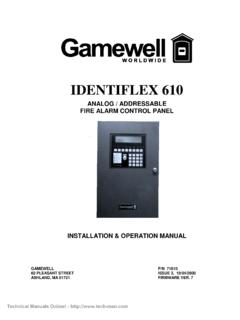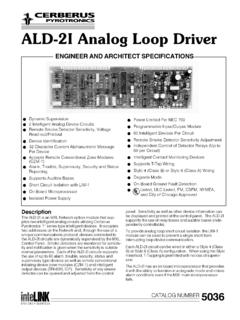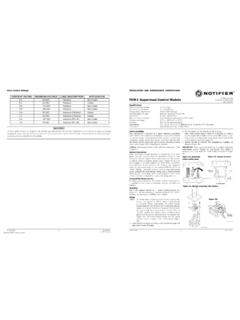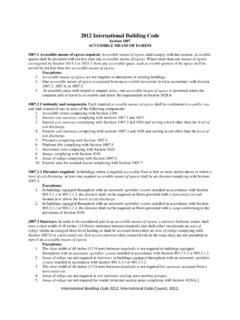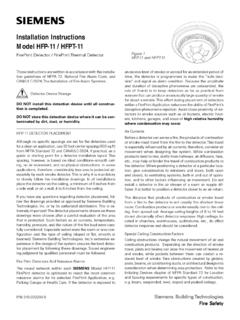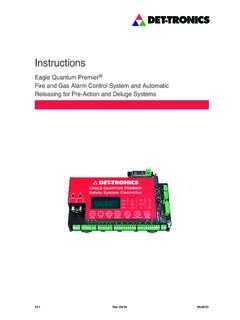Transcription of MODEL ICP-B6 Intelligent Control Point - Home - …
1 Installation InstructionsMODEL ICP-B6 Intelligent Control PointThe SIEMENS MODEL ICP-B6 IntelligentControl Point can be used as an independent,remotely located telephone zone, a speakerzone (25V or RMS), or notificationappliance circuit (NAC), depending on how it isconfigured. It communicates through theanalog loop of the MXL/MXLV to 12 ICP-B6s can connect to each analogloop of the MXL/MXLV. These modules mustbe connected to the first 12 address locationson the analog 24 VDC power input for each ICP-B6comes from either the MMB, the PSR, or froman auxiliary power supply which is powerlimited and UL listed for fire protective signal-ing use and is rated between 24 and Each ICP-B6 can be assigned a 32-character, custom alphanumeric module uses one address on either theanalog loop of the ALD-2I module or the analogloop of the MMB board.
2 (See Figure 1.)Addressing and TestingUse the DPU Device Programming Unit or theFPI-32 Programmer/Tester (Sensor-LINK) toprogram and test the :With FPI-32 Rev. software, only1=MXL mode should be used whenprogramming a Set the ICP-B6 Module Address: 1. Plug the programming cable of the DPU orFPI-32 Programmer/Tester (SensorLINK)into the two-pin receptacle on the ICP-B6 .(See Figure 2 for location only.)2. Set the system address for the ICP-B6 byfollowing the instructions in the FPI-32(SensorLINK) Programmer/Tester Manual,P/N 315-090077, or the DPU User'sManual, P/N 315-033260, as all system power before instal-lation, first battery and then AC.
3 (To powerup, connect the AC first, then the battery.)All wiring must comply withnational and local ICP-B6 should be installed in a ULlisted electrical box. (See Figure 10.)Analog LoopThe ICP-B6 communicates with the MXLthrough its analog addressable loops. Theseloops are on either the MMB or on the optionalALD-2I module of the MOM-4. They may bewired for Class A (Style 6) or Class B (Style 4).Figure 1 shows both wiring types and theconnections to either the MMB or to theMOM-4 when the ALD-2I module is used. Thetable on the following page lists the maximumoutput currents SafetyP/N 315-095306-7 Siemens Building Technologies, Fernwood RoadFlorham Park, New Jersey 07932 Siemens Building Technologies, Kenview BoulevardBrampton, Ontario L6T 5E4 CN2 The ICP-B6 module can be used in fourdifferent ways:1.
4 Using the ICP-B6 as an NAC ModuleThis notification appliance application uses theprinciple of polarity reversal when there is analarm. Figure 2 shows the polarity connectionin a supervisory condition. When using theICP-B6 as a supervised NAC output modulewith notification appliance devices, cut jumperJP2. Refer to Figure 2 for additional connec-tion and jumper information, and to P/N 315-096363 for a list of compatible ALLOWABLE ICP-B6 OUTPUT CIRCUIT LINE RESISTANCEFOR SPECIFIED DC RISER CURRENT AND LINE RESISTANCEMAXIMUMDC RISERCURRENT(in Amps)DC RISER RESISTANCE (in Ohms) Ohm1 LOOP RESISTANCE FOR EACH ICP-B6 ON RISERNOTES:1.
5 Resistances specified are for both If higher currents are required, Siemens Building Technologies, Inc. recommends using a localauxiliary supply which is UL listed for fire protection signaling use. The supply should be ratedbetween 24 and used as an NAC module, the outputcircuit is power limited. The ICP-B6 maximumcurrent is at 24 VDC. If the 24 VDC islost or the NAC line is broken or shorted, thetrouble condition INPUT DEVICE RESPONSETOO LOW displays at the MXL/MXLV controlpanel. Refer to Figures 3 and 4 for the con-nections used with the TRI-60/B6 module andthe PSR-1 module, respectively.
6 See the LineResistance chart for the allowable line resis-tance for each ICP-B6 output 2 ICP-B6 Used as a Strobe ModuleFigure 1 Analog Loop Connections100 OHMS MAXANALOG LOOP CONNECTION(T-TAPPING ALLOWED)OPERATES IN FULL CONFORMANCE WITH STYLE 4 (CLASS B)*JUMPERS CAN BE REMOVED FROM MMB-3 WITH CSGM CONFIGURATION**TB1TB1TB1 ICP-B6 ICP-B6 ICP-B6121212 ALD-2 IALD-2 IMOM-4TB2 MOM-4TB1 MMBTB2 MMBTB3 LOOP 1 LOOP 2 LOOP 1 LOOP 2 LOOP 1 LOOP 2432187654321876543214321432187654321876 543214321 LOOP RESISTANCE 100 OHMS MAX18 AWG MINIMUM WIRENO EOL DEVICE REQUIREDSUPERVISED.
7 POWER LIMITED PER NEC 760 ALL WIRING MUST CONFORM TO NATIONAL ANDLOCAL ELECTRICAL CODES4 Figure 4 ICP-B6 Connections Using PSR-1 Figure 3 ICP-B6 Connections When Using TRI-60 the ICP-B6 as a Telephone ZoneWhen the ICP-B6 is used as a telephone zonemodule, the 24 VDC provides supervision,trouble, and call-in conditions. If the 24 VDC islost, the trouble condition INPUT DEVICERESPONSE TOO LOW displays at the MXL/MXLV and an LED for that zone lights at theVSM-1 supervised telephone common talk riserstarts at the TBM module in the MME-3 back-box.
8 The Class B shielded cable connectscontinuously to each ICP-B6 with a end ofline device. Tie the shield of these riser wiresand the shield of the zone output wires togetherusing terminal 5 of TB2 and isolate them fromthe system circuits and the earth the supervised individual zone outputconnections from each ICP-B6 to the fieldtelephone with shielded cable. Terminate themat the last station with a 10K ohm end of lineresistor. As with the common talk line de-scribed in the paragraph above, be sure thatthe shield is continuous and isolated fromFigure 5 ICP-B6 Used as a Telephone Zoneboth system circuits and earth ground andthat the shields are connected togetherusing terminal 5 of Using the ICP-B6 as a 70 Volt SpeakerZoneWhen the ICP-B6 is used as a speaker zone,the 24 VDC provides the supervision.
9 If the 24volts is lost or there is an open or shortedspeaker output line, the trouble conditionINPUT DEVICE RESPONSE TOO LOWdisplays at the MXL/MXLV and the relatedzone LED on the VSM-1 RMS audio input comes from theamplifier via the ASC-2 Amplifier Supervisioncard. The ASC-2 supervises the audio connec-tion path to the ICP-B6 and provides up to 100watts of power. The ASC-2 can be used asStyle Y (Class B) or Style Z (Class A). Refer tothe ASC-2 Instructions, P/N the ICP-B6 is used as a speaker zone,the output speaker lines are supervised andpower limited.
10 The audio output cannot exceed625 watts. Connect the speaker output as eitherStyle Y (Class B) or Style Z (Class A). Figure 6gives the approximate decibel loss for the totalspeaker zone wire length for various wiregauge using the ICP-B6 as a RMSspeaker zone, cut the JP1 jumper. (SeeFigure 8.)4. Using the ICP-B6 as a 25 Volt SpeakerZoneWhen the ICP-B6 is used as a speaker zone,the 24 VDC provides the supervision. If the 24volts is lost or there is an open or shortedspeaker output line, the trouble conditionINPUT DEVICE RESPONSE TOO LOWdisplays at the MXL/MXLV and the relatedzone LED on the VSM-1 25V RMS audio input comes from theamplifier via the ASC-2 Amplifier Supervisioncard.
